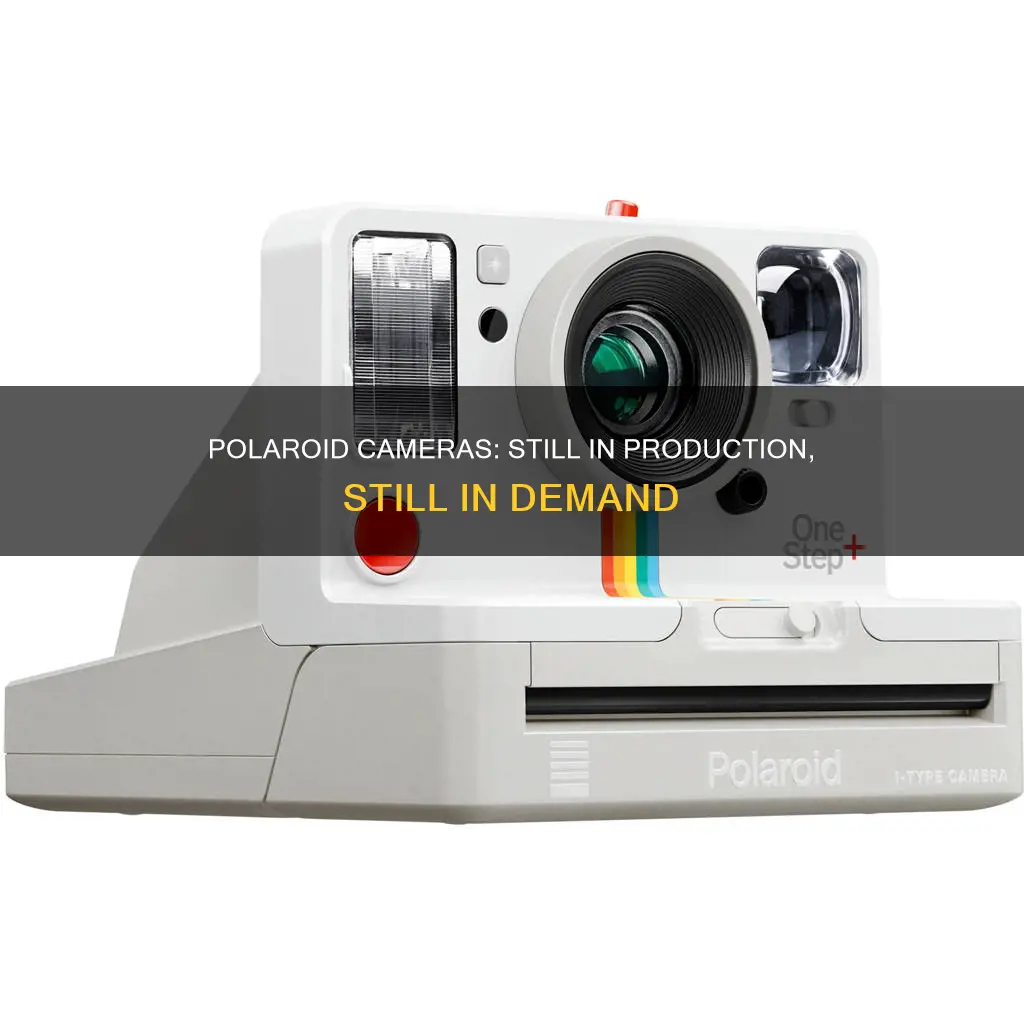
The Polaroid camera, invented by Edwin Herbert Land, was a modern marvel during its inception in the late 1940s. It was easy to use and provided instant prints, making it a popular choice for photo enthusiasts. However, with the advent of digital cameras and smartphones, Polaroid cameras started to see a decline in sales. Despite this, Polaroid cameras have made a comeback in recent years, gaining popularity once again. The nostalgia for analogue photography and the tactile nature of Polaroid pictures have drawn in a new generation of users. Today, Polaroid offers a range of instant cameras with modern features such as app connectivity, multiple exposure modes, and built-in filters, catering to those who want the best of both analogue and digital worlds.
| Characteristics | Values |
|---|---|
| Company | Polaroid Corporation |
| Founder | Edwin H. Land |
| Founded | 1937 |
| Initial Market | Polarized Sunglasses |
| First Instant Camera | Land Camera, 1948 |
| Peak Employment | 21,000 in 1978 |
| Peak Revenue | $3 billion in 1991 |
| Current Status | Still in business |
What You'll Learn

The Polaroid camera's history
The Polaroid Corporation was founded in Cambridge, Massachusetts, in 1937 by Edwin Land, a scientist and inventor, and George W. Wheelwright III. Land had dropped out of Harvard University to start inventing in a Cambridge garage. He invented the artificial polarizer, which splits light waves into separate beams, and his first product was the polarizing filter, which was bought by Kodak.
Polaroid was initially known for its polarizer technology, which was used in products such as 3D movies and protective goggles for military dogs. During World War II, the company designed and manufactured products for the armed services, including an infrared night-viewing device.
In 1944, Land's three-year-old daughter asked him why she couldn't see the picture he had just taken of her. This inspired Land to develop the first instant camera, the Polaroid Land Camera, which was released in 1947 or 1948. The first Polaroid camera still required the photographer to manually time the development of the film, pull out the print, burst a pod of developing chemicals, and peel away the top film. These first prints were in sepia tone, followed by black-and-white prints in 1950.
As the technology progressed, it became possible for the prints to develop within a minute in front of the user's eyes. By 1977, Polaroid held two-thirds of the instant camera market, despite competition from Kodak. However, sales of instant cameras began to decrease around 1979 as video cameras and 35-millimetre cameras became smaller and cheaper.
In the 1980s, Polaroid tried to shift away from its dependence on consumer photography, a market that was in steady decline. The company also faced competition from Kodak, which announced instant film cameras in 1976. Polaroid sued Kodak, accusing them of stealing its patented instant photography process, and won the decade-long lawsuit. However, the rise of digital photography in the 1990s and 2000s led to a decline in Polaroid's sales.
In 2001, Polaroid filed for bankruptcy, and the brand and assets were sold off. The company continued to change hands until it was acquired by Polish billionaire Wiaczesław Smołokowski in 2017. The Impossible Project, a company formed to continue producing instant films for older Polaroid cameras, was rebranded as Polaroid Originals in 2017 and then as Polaroid in 2020.
Today, Polaroid continues to innovate in instant photography, releasing new instant cameras and film systems.
Unleashing Creative Control: Camera Raw Filter's Power
You may want to see also

The Polaroid camera's decline
The Polaroid camera, invented by Edwin Herbert Land and released in 1947, was an instant marvel of its time. However, the Polaroid Corporation, despite its success and stature, faced a decline in the 1990s due to various factors, eventually filing for bankruptcy in 2001.
The Rise of Digital Photography
The advent of digital photography in the 1990s and 2000s significantly contributed to the decline of Polaroid. Consumers were drawn to the affordability of disposable cameras and the emerging trend of digital photography. The introduction of smartphones equipped with cameras in the mid-2000s further diminished the demand for Polaroid cameras.
Competition from Other Brands
In 1976, Kodak's announcement of instant film cameras posed a significant threat to Polaroid's dominance. This competition intensified with the introduction of single-use cameras from competitors and the emergence of videotape camcorders.
Failure to Adapt
Polaroid's failure to adapt to the changing market and anticipate the impact of digital cameras on its film business is often cited as a critical factor in its decline. The company struggled to capture a large market share in the digital camera segment, even as consumer preferences shifted towards more modern and convenient options.
Management Issues
The bankruptcy of Polaroid has been largely attributed to the failure of senior management. This type of managerial breakdown, known as the success trap, led to wholesale changes, including layoffs and factory closures.
Financial Mismanagement
Polaroid's financial mismanagement also contributed to its decline. The company's executives received large bonuses during the bankruptcy process, while stockholders, employees, and retirees were left with nothing. This criticism surrounding the "takeover" further damaged the company's reputation.
The Polaroid Comeback
Despite the challenges, Polaroid has made a comeback, fueled by nostalgia and a desire for tangible photographs. The brand has been revived, and Polaroid-branded products, including instant cameras and films, are once again gaining popularity, especially among younger generations seeking a link to the past.
Samy's Camera: Tax-Free Shopping Experience
You may want to see also

The Polaroid camera's comeback
The Polaroid camera has made a comeback, and it's not just about nostalgia. Once resigned to the shadows due to the advent of digital cameras, the Polaroid is now trending again, with new generations of the camera that provide the same instantly tangible souvenir of a moment.
A Brief History of Polaroid
The first instant Polaroid camera was created by Polaroid Corporation founder Edwin H. Land in 1948. At that time, the instant printing process hadn't been perfected, and photographers had to time things precisely and use a pod of film-developing chemicals. These prints were sepia-toned, and two years later, in 1950, black-and-white Polaroid film was introduced. Color film for these cameras came in 1963, and by the 1970s, the Polaroid film we know today was introduced. During this decade, the Polaroid camera quickly grew in popularity, and even though instant cameras from other brands were introduced, they never quite reached Polaroid's ubiquity.
The Decline of Polaroid
In the mid-1990s, the Polaroid camera started to see a dip in sales as customers opted for more affordable disposable cameras and those with more money to spend got into digital photography. By the mid-2000s, smartphones started coming equipped with cameras, delivering a more powerful and instant process than the Polaroid.
The Comeback
So, why are Polaroids back? Well, nostalgia certainly played a role, but it's not just that. There's something special about taking a photo that you can actually hold in your hands and have as a keepsake. In the late 2010s, young people who weren't even around for the golden age of Polaroid began to see the camera's unique appeal. Like vinyl records, Polaroids enjoyed a renaissance as a hip, must-have item that provided a meaningful sense of tactility and a stylish link to the past.
Today's Polaroid models have also gotten a makeover to bring them into the digital age. They often allow users to capture digital images alongside instant prints and offer a more compact design, higher resolution, better color accuracy, and creative features such as multiple exposure modes, self-timers, and built-in filters.
The Value of Vintage Polaroids
If you have a vintage Polaroid camera, it may be worth big bucks. On eBay, many vintage Polaroids have asking prices over $1000, with some reaching nearly $7000. The most valuable Polaroid model is the Folding SLR Series, designed by Edwin H. Land himself. These cameras have an innovative design that allows them to fold flat and are now rare and highly sought after by collectors and photographers.
So, if you have a vintage Polaroid, you may be inspired to buy some film and start snapping away, or you could look into selling it to a large market of photographers and retro collectors.
Lightroom and Camera Raw: What's the Deal?
You may want to see also

The Polaroid camera's value
Polaroid cameras are valued for their nostalgic appeal, unique retro aesthetic, and their ability to produce instant prints. The value of a Polaroid camera depends on several factors, including rarity, functionality, condition, and aesthetics.
Rarity and Functionality
The rarer a Polaroid model is, the more valuable it tends to be. Some models, like the Polaroid Spectra 2 AF, can be worth as little as $13 if untested and in poor condition, but can fetch prices of around $90 if they are in good working condition. The oldest models, such as the Model 100 Land Camera, tend to be highly sought after, especially if they are in working condition.
Condition and Aesthetics
The cosmetic condition of a Polaroid camera also affects its value. A camera that is beaten up or damaged will be worth less than one that is in pristine, functional condition. Additionally, having the original box, manual, and other accessories can further increase the value of the camera.
Instant Photography
Polaroid cameras revolutionized the photography industry by introducing instant photography to the market. The ability to take a photo and develop it in under a minute was a groundbreaking innovation that captivated consumers. This technology, combined with the camera's ease of use, contributed to its massive popularity.
Nostalgia and Retro Aesthetic
Polaroid cameras hold a nostalgic value for many people, evoking memories of a bygone era before digital cameras and smartphones. The instant prints produced by Polaroid cameras have a unique, retro aesthetic that is difficult to replicate with modern digital cameras. This distinctive look has led to a resurgence in the popularity of Polaroid cameras, particularly among younger generations seeking tangible, physical photographs.
In summary, the value of Polaroid cameras lies in their technological innovation, their ability to produce instant prints, their nostalgic appeal, and the unique aesthetic they bring to photography. The specific value of a Polaroid camera depends on a combination of factors, including rarity, functionality, condition, and aesthetic qualities.
Finding the Remaining Battery Life on Your Canon SX10 IS
You may want to see also

The Polaroid camera's future
The Polaroid camera has had a long and tumultuous history since its inception in the late 1940s. After enjoying immense popularity for several decades, the advent of digital photography in the 1990s and 2000s led to a decline in sales and eventually, the company's bankruptcy in 2001. However, the Polaroid brand has persevered and evolved, and today, Polaroid cameras are once again gaining popularity. So, what does the future hold for this iconic camera?
Innovation and Adaptability:
The Polaroid camera has always been synonymous with innovation. From its beginnings as the first instant camera to its recent reinvention, Polaroid has continued to adapt to changing consumer needs and market trends. The current Polaroid company offers a range of instant cameras, from the classic Polaroid Now to the app-connected Polaroid Now+ and the world's smallest instant camera, the Polaroid Go. These modern Polaroids combine the nostalgia of instant photography with digital features like autofocus, multiple exposure modes, and Bluetooth connectivity.
Nostalgia and Tangibility:
One of the key factors in the resurgence of Polaroid cameras is nostalgia. In an increasingly digital world, there is a growing appreciation for tangible, physical photographs. Polaroid pictures offer a unique, one-of-a-kind memento that cannot be replicated by digital images. This tangibility has attracted a new generation of users who value the tactile experience of holding a photo in their hands.
Collaborations and Brand Awareness:
Polaroid has also capitalized on collaborations to boost its brand awareness and appeal to new audiences. From appointing Lady Gaga as their "Creative Director" in 2010 to partnering with urban outfitters like Urban Outfitters, Polaroid has positioned itself as a hip and trendy brand. These collaborations have helped to introduce Polaroid to a new generation of consumers who may not have been familiar with the brand's rich history.
Expanding Product Line:
In addition to its core instant camera business, Polaroid has expanded its product offerings. The company now sells a range of consumer electronics, including LCD televisions, DVD players, and digital cameras. By diversifying its product line, Polaroid is able to reach a wider audience and strengthen its brand presence in the market.
Challenges and Competition:
However, the future of Polaroid cameras is not without its challenges. The high cost of instant film, which can be upwards of $1 per photo, may deter some consumers, especially those who are used to the convenience and low cost of digital photography. Additionally, Polaroid faces competition from other instant camera brands, such as Fujifilm's Instax series, which offers similar features at more affordable price points.
The Polaroid camera has endured and evolved over the years, adapting to changing technologies and consumer preferences. While the future is uncertain, there is a clear demand for the nostalgia, tangibility, and creativity that Polaroid cameras offer. By continuing to innovate, embrace new technologies, and cater to the needs of its diverse customer base, Polaroid can ensure its place in the ever-changing world of photography.
HDMI: Powering Cameras or Just for Data Transfer?
You may want to see also
Frequently asked questions
Yes, Polaroid cameras are still being made and are currently sold on the Polaroid website. The company has rebranded several times since its bankruptcy in 2001 and has changed hands multiple times. The current Polaroid company produces and sells Generation 2 cameras, including the Polaroid Now and the Polaroid Go, which is the world's smallest instant camera.
New Polaroid cameras have a more compact design, higher resolution, better colour accuracy, and creative features such as multiple exposure modes, self-timers, and built-in filters. They also often allow users to capture digital images alongside instant prints.
Polaroid cameras can be purchased on the official Polaroid website, as well as from third-party retailers such as Urban Outfitters and Amazon.







